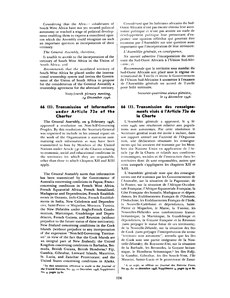United Nations list of Non-Self-Governing Territories
| UN General Assembly Resolution 66 (I) |
|
|---|---|

United Nations General Assembly Resolution A/RES/66 (I) dated 14 January 1946
|
|
| Date | 14 December 1946 |
| Meeting no. | Sixty fourth |
| Code | A/RES/66(1) (Document) |
| Subject | Transmission of information under Article 73e of the Charter [relating to non-self-governing territories] |
| Result | Adopted |
The United Nations list of Non-Self-Governing Territories is a list of places that the United Nations General Assembly deems to be "non-self-governing" and subject to the decolonization process. Chapter XI of the United Nations Charter embodies a "Declaration on Non-Self-Governing Territories" which declares that the interests of the occupants of dependent territories are paramount and requires U.N. member states in control of non-self-governing territories to submit annual information reports concerning the development of those territories. Since 1946, the General Assembly has maintained a list of non-self governing territories under member states' control. Since its inception, dozens of territories have been removed from the list, typically when they attained independence or internal self-government, while other territories have been added as new administering countries joined the United Nations or the General Assembly reassessed the status of certain territories.
The United Nations Charter contains a Declaration Concerning Non-Self-Governing Territories. In Article 73e of the Charter, member States agree to report to the United Nations annually on the development of non-self-governing territories under their control. The initial List of Non-Self-Governing Territories was created by compiling lists of dependent territories submitted by the administering States themselves. In several instances, administering States were later allowed to remove dependent territories from the list, either unilaterally (as in the case of many French overseas departments and territories), or by vote of the General Assembly (as in the cases of Puerto Rico, Greenland, the Netherlands Antilles, and Suriname).
The list draws its origins from the period of colonialism and the Charter's concept of non-self-governing territories. As an increasing number of formerly colonized countries became UN members, the General Assembly increasingly asserted its authority to place additional territories on the List and repeatedly declared that only the General Assembly had the authority to authorize a territory's being removed from the list upon attainment of any status other than full independence. For example, when Portugal joined the United Nations, it contended that it controlled no non-self-governing territories (because areas such as Angola and Mozambique were purported to be an integral part of the Portuguese state), but the General Assembly rejected this position. Similarly, Western Sahara was added in 1963 when it was a Spanish colony. The same can be said about the situation of Namibia (removed upon its independence in 1990), which was seen, due to its former status as a League of Nations mandate territory, as a vestige of German colonial legacy in Africa. A set of criteria for determining whether a territory is to be considered "non-self-governing" was established in General Assembly Resolution 1541 (XV) of 1960.
...
Wikipedia
